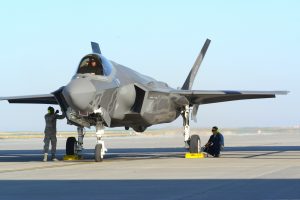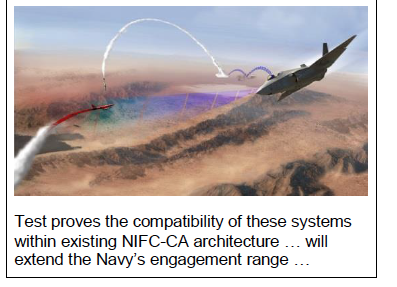2016-09-29 Recently, the new Chief of Staff of the USAF, General David Goldfein, referred to the “moral imperative of high end training.”
“I came to believe that high end training against the most difficult threat in the most difficult environment is nothing short of a moral obligation, and we had proved it in Desert Storm.”
Clearly, he had in mind the kind of training, which F-35 flight instructors just underwent at Mountain Home AFB.
This training is built from the ground up with key allies who train with the U.S. and in this case, namely the Royal Australian Air Force.
According to an article by Sgt, Timothy Boyer, 56th Wing Public Affairs, F-35 pilots from Luke AFB have flown to Mountain Home and operated there as part of their training.
Seven Luke F-35s were at Mountain Home Air Force Base, Idaho, September 10 through 24, 2016, for pilot training.
While this is not the first time Mountain Home AFB has supported F-35s, it is the first time the base has supported Air Education and Training Command pilot training.
“The main objective of this training deployment was to increase our instructor pilots’ proficiency in finding and destroying surface-to-air threats, which is a bread-and-butter mission for the F-35,” said Lt. Col. Michael Gette, 61st Fighter Squadron commander.
“Mountain Home AFB provides a unique opportunity for this training due to their outstanding range complex, which includes several surface-to-air threats we can ‘fight’ in increasingly complex scenarios.”
The success of the Mountain Home AFB training deployment was dependent on many Airmen.
There were approximately 100 personnel participating in the exercise, including 80 maintainers and 15 pilots as well as seven contractors who helped with mission planning and security, according to Gette.
In addition to sharpening the pilots’ warfighting skills, aircrew had the opportunity to practice a deployment-style scenario with a partner nation.
“This was the first F-35 training deployment to include partner pilots,” Gette said.
“Being able to deploy and train with our Royal Australian Air Force partners was an important step for the squadron and for the program as we continue to stand-up partner training at Luke AFB.”

While the RAAF has had F-35s at Luke AFB since December 2014, this mission was an important joint experience.
“The Mountain Home deployment provided an opportunity to improve F-35 operator knowledge and skills while working hand in hand with our U.S. Air Force colleagues,” said Squadron Leader Andrew Jackson, 61st FS RAAF Senior National Representative.
“Opportunities such as these provide invaluable stepping stones in building a solid fifth generation, warfighting capability for the RAAF. As the first partner nation to arrive and train at Luke AFB, the opportunity to deploy to Mountain Home AFB with AETC is an exceptional training opportunity as we work toward our own IOC in 2020.”
The trip to Mountain Home AFB ultimately met the goals they set out to achieve.
“The Mountain Home Range Complex gave us a really unique opportunity to train against multiple surface-to-air threats,” Gette said.
“We appreciate Mountain Home AFB and the support from the community for their very warm welcome. We got everything we needed and the training deployment went very well.”
And on the Naval Aviation side of the house, the Navy has conducted its first live fire NIFC-C tests with the F-35.
According to a press release from White Sands Missile Test Range, New Mescio and dated 9/13/16:
The Navy hosted its first live fire demonstration to successfully test the integration of F-35 with existing Naval Integrated Fire Control-Counter Air (NIFC-CA) architecture, Sept. 12.
During the test, an unmodified U.S. Marine Corps F-35B from the Marine Operational Test and Evaluation Squadron (VMX 1), based in Edwards Air Force Base, acted as an elevated sensor to detect an over-the-horizon threat.
The aircraft then sent data through its Multi-Function Advanced Data Link to a ground station connected to USS Desert Ship (LLS-1), a land-based launch facility designed to simulate a ship at sea.
Using the latest Aegis Weapon System Baseline 9.C1 and a Standard Missile 6, the system successfully detected and engaged the target.

While the goal of this test was to prove the compatibility of these systems within existing NIFC-CA architecture, this future capability will extend the Navy’s engagement range to detect, analyze and intercept targets in operational settings.
Using any variant of the F-35 as a broad area sensor, the aircraft can significantly increase the Aegis capability to detect, track and engage.
“This test was a great opportunity to assess the Navy’s ability to take unrelated technologies and successfully close the fire control loop as well as merge anti-surface and anti-air weapons into a single kill web that shares common sensors, links and weapons,” said Anant Patel, major program manager for future combat systems in the Program Executive Office for Integrated Warfare Systems (PEO IWS).
The test was a collaborative effort across the Navy and Marine Corps, White Sands Missile Range and industry partners leveraging a U.S. Marine Corps F-35B and the U.S. Navy’s Aegis Weapon System to support the distributed lethality concept in the Fleet. “
This test represents the start of our exploration into the interoperability of the F-35B with other naval assets,” said Lt. Col. Richard Rusnok, VMX-1 F-35B detachment officer in charge.
“We believe the F-35B will drastically increase the situational awareness and lethality of the naval forces with which it will deploy in the very near future,” he added.
Aegis Baseline 9 delivers a fully open architecture system on U.S. destroyers and is the basis for current and future Aegis Integrated Air and Missile Defense.
Baseline 9 is being fielded on in-service destroyers, new construction destroyers and Aegis Ashore.
The Aegis Common Source Library enabled derivatives are on the Coast Guard cutters, Freedom-variant Littoral Combat Ships and will be included on the upcoming frigate ships.
Clearly, this is what the Navy means when it refers to distributed lethality.

